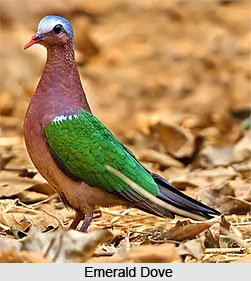 Emerald Dove with scientific name Chalcophaps indica is also known as the Green-winged Pigeon. It is commonly found from the Indian subcontinent to southern China, Southeast Asia and northern Australia. It is a medium sized pigeon with six sub-species like indica, robinsoni, maxima, augusta, natalis and minima. It is the state bird of the Indian state of Tamil Nadu.
Emerald Dove with scientific name Chalcophaps indica is also known as the Green-winged Pigeon. It is commonly found from the Indian subcontinent to southern China, Southeast Asia and northern Australia. It is a medium sized pigeon with six sub-species like indica, robinsoni, maxima, augusta, natalis and minima. It is the state bird of the Indian state of Tamil Nadu.
Concentration of Emerald Dove
The Emerald Dove is found in the tropical and sub-tropical parts of the Indian Subcontinent and east through Myanmar, Thailand, Malaysia, the Philippines, and Indonesia, to northern and eastern Australia. Also its sub-species are recognized in India to south China, Malaysia, Philippines, Indonesian and west Papuan islands, robinsoni in Sri Lanka, maxima in Andaman Islands, augusta in Nicobar Islands, natalis in Christmas Island (Indian Ocean) and minima in Numfor, Biak and Mios Num islands.
Gender of Emerald Dove
Male Emerald Dove has blue-grey crown and nape, unmistakable metallic green mantle and wings with white shoulder-patch, white forehead and eyebrow and red bill. Female Emerald Dove resembles male but has less grey on head and no white on wings. The young birds are more like the females but they have brown scallops on their body the feathers of the wing.
Anatomy of Emerald Dove
The Emerald Dove is a sturdy, medium sized pigeon with a length of 23 to 28 centimeters in and weighing 90 to 170 grams. These birds are sexually dimorphic. The back and the wings of the bird are bright emerald green in colour. The flight feathers and tail are blackish and the broad black and white bars show on the lower back when the bird is flying. Their call is a repeated, low-pitched, mournful cooing sound. It often flies low between the patches of dense forest it prefers, but when disturbed will frequently walk away rather than fly. They are particularly good weavers when flying through forests.
Colour of Emerald Dove
It is a brightly-colored dove of the forest floor with bright green wings, coral-red bill, and ash-gray forehead. When flying, they expose a buff under wing and a chestnut colour of their flight feathers. The head and the lower parts of the body are dark vinous pink, which lightens to a grayish colour on the lower side. The eyes are dark brown in colour; the bill is bright red and the legs.
Description of Emerald Dove
In 1743 the English naturalist George Edwards included a picture and a description of the common emerald dove in his “A Natural History of Uncommon Birdsâ€. He used the English name "Green Wing`d Dove". His drawing was made from a live bird at the home a merchant in Rotherhithe near London. Edwards was told that the dove had come from the East Indies. When in 1758 the Swedish naturalist Carl Linnaeus updated his Systema Naturae for the tenth edition, he placed the common emerald dove with all the other pigeons in the genus Columba. Linnaeus included a brief description, coined the binomial name Columba indica and cited Edwards`s work. The specific epithet indica is Latin for "Indian" and is used by Linnaeus to denote the East Indies. The species is now placed in the genus Chalcophaps that was introduced by the English ornithologist John Gould in 1843.
Nature of Emerald Dove
Emerald Doves are not gregarious and they occur singly, in pairs and sometimes in small groups. They are quite terrestrial and survive on seeds, fruits and a wide variety of plants. They can be tamed easily and are approachable. The call of the Emerald Doves is low soft moaning cooing consisting of six to seven coos, which starts quietly and rises. During courtship, the males perform a bobbing dance to woo the female counterpart.
Habitat of Emerald Dove
The natural ecosystems and habitats of these common emerald dove species include tropical and subtropical moist lowland forests, mangrove forests, moist montane forests, rainforests and evergreen forests. Emerald doves usually occur singly, pairs or in small groups. They are quite terrestrial, often searching for fallen fruit on the ground and spending little time in trees except when roosting. They eat seeds and fruits of a wide variety of plants and are generally tame and approachable. Its flight is fast and direct, with the regular beats and an occasional sharp flick of the wings which are characteristic of pigeons in general. It often flies low between the patches of dense forest it prefers, but when disturbed will frequently walk away rather than fly. They are particularly good weavers when flying through forests. When flying they expose a buff underwing and a chestnut colour of their flight feathers.
These common emerald dove species are non-migratory, resident birds. The birds in higher altitudes move to lower levels and plains during winter.



















